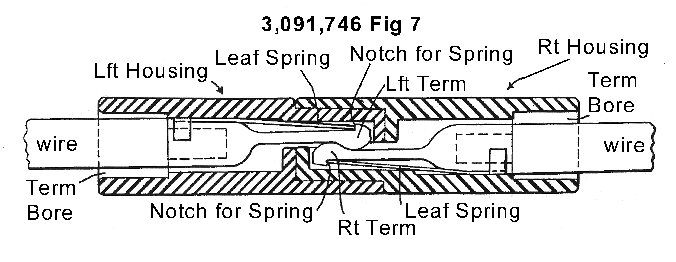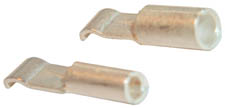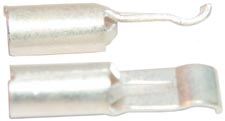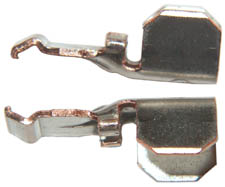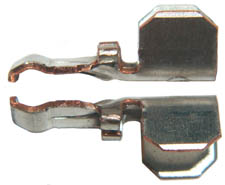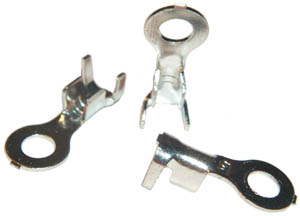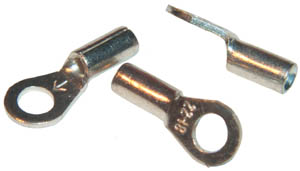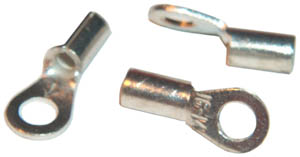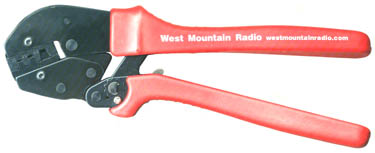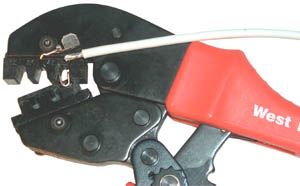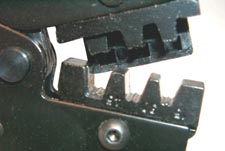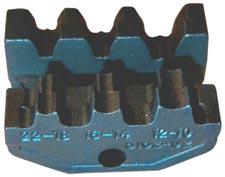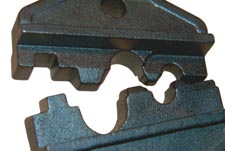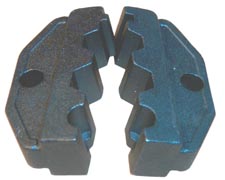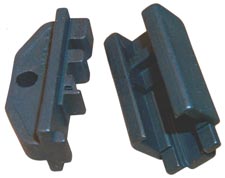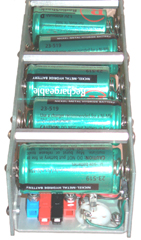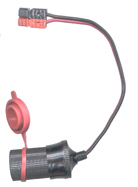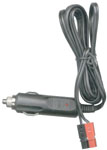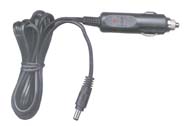Power Pole
© Brooke Clarke, N6GCE 2003 - 2006 |
Power
Pole ARES Configuration Red on Right "A" Reads Right |
Cigarette Lighter Plugs and Sockets
Power Pole Connectors
Cutaway Photos
Hermaphroditic
Contacts
Wire Stranding vs. Power Pole Contacts
Crimping
Wire Terminals
Power Pole Assembly Tips
Wire Strippers
Crimp Tools
West Mountain Crimp Tool
Crimp Die Photo Table
12 Volt Power
24 Volt Power - 24 Volt Connector
Power Pole Products
Links
Background
There's a need for a simple, inexpensive, easy to use, fool proof connector for use in applications where the classical Cigarette Lighter system is now used.
Cigarette Lighter Plugs and Sockets
The Cigarette Lighter system is common as a "12 Volt" vehicle power connector, but has a number of problems.
Comes apart by Itself
For me the biggest problem is that the connection seems to be designed to separate all by itself. The spring loaded plunger on the plug will push the plug out of the socket given time and any vibration.
Plugs Fall Apart
Some Cigarette Lighter plugs have a plunger that tends to fall out of the plug and get lost.
Current Limited
A cigarette Lighter connection is typically rated at 10 Amps max.
Power Pole Connector
Anderson Power Products makes a line of wire connectors, one of which is called the "Power Pole". The Power Pole uses a patented design. The 15, 30 and 45 Amp Housings are all the same, the contact Terminal changes for the different current ratings.
The mating connection is hermaphroditic (each connector is both male and female) and so only one type connector is needed. In a classical plug and socket arrangement the source of power was connected to the socket and the load connected to the plug. Since the Power Pole connector is both a plug and a socket this distinction need no longer be made. The same connector pair can be used for taking power out of a battery or charging the battery, greatly adding to the flexibility of the system.
Also, shown only in the two newest patents referenced below, each side of the housing has a dovetail groove or tongue so you can stack the housings side by side and/or top to bottom. There may be as many as 12 different ways to connect two housings. ARES has standardized a pairing scheme for a red and a black housing for use with common "12 Volt" equipment using either the 15 Amp or the 30 Amp contacts.
Red on the right looking into the open end with the contact up (hole down) Terminals in a line, not parallel not "T".
Patent Drawing
3259870 Electrical Connector, July 5, 1966, E. D. Winkler, 439/2955; 174/50; 439/701 - This is the Power Pole with the dovetail interlocking system. Power Poles can be stacked side by side and top to bottom with the blades either in line or at right angles.
3218599 Electrical Connector, Nov. 16, 1965, E. D. Winkler, Class: 439/295; 29/876; 439/744 - provides a way to capture the leaf spring by pressing it into the plastic, has the dovetail interlocking
3091746 Electrical Connector, May 28, 1963, E. D. Winkler, Class: 439/295; 439/744 - single piece housing, but no dovetail
2838739 Electrical Connector, June 10, 1958, E. D. Winkler, Class: 439/295 - uses a two piece housing for a single wire. no way to combine
Hermaphroditic
The Contact and spring are a little closer to the mating end in an normal Power Pole, Cutting the housing open allowed the spring to move. You can also see that the actual electrical connection is between the terminals and there is a wiping action every time a connection is made. Any arcing or pitting will occur at the tips of the terminals, not at the final mated position.
The above photos are the same, only one has been turned upside down to show how they mate. Demonstrating the hermaphroditic nature of this connector. (Each connector is both a male and a female.) This is THE number one advantage that this connector has over all the others. For example an extension cord will have exactly the same connector on both ends. A connector can be used for charging a battery or powering a load from a battery. I can't overemphasize how important this property is. It makes everything very very much easier than if you were to use a conventional connector that has male and female as seperate parts.
But it turns out that even though a single Power Pole connector is hermaphroditic most combinations of two or more of them are not!
The ARES configuration is the only two terminal combination that preserves the hermaphroditic property (except for the one with red and black reversed). See below for a 24 Volt connector pair that is also hermaphroditic.
Contacts
The PP15 insulating shells will accept contacts rated for 15, 30 or 45 Amps. Contact rating depends on temperature rise. So you may want to use a contact rated for a current much higher than your application if you want a lower resistance contact.
The Hi and Low Détente versions have a different mating force and feel. Low Détente is the only type of contact for 15 Amps.
Two Low Détente have 3 pound mating force, and two high Détente mate with 5 pound force. One each Low and High Détente mates with 4 pounds.
The electrical performance is the same, but the high Détente contacts are better for high vibration environments.
When crimps made with the Harbor Freight and West Mountain Radio tools are compared the West Mtn. Radio crimp looks a little nicer, but either of them is a good crimp.
Contacts are available on reels of 5,000 and as Loose Piece Bulk Pack (-LPBK). It may be that if you use diagonal cutters to separate individual contacts from a reel the pinched part of the contact may be too wide to allow the contact to fit into the shell. The incentive to buy a full reel is a much lower price per contact. If you have separated contacts from a reel in a way that worked please let me know.
There are two versions of the 30 and 45 amp contacts. The standard version is for stranded wire where all the strands are in a single bundle. The other version is for super flex type wire where the strands are finer and in a number of bundles. The above information from the Anderson factory.
The contacts are designed to enclose some range of wire areas. But the area for the same American Wire Gauge (AWG) size varies depending on the stranding.
5 Nov 2007 - First cut at matching wire to possible contacts for crimping.
Wire Stranding vs. Power Pole Contacts
Note a single strand is the smallest diameter for a given AWG size. As the number of strands increased the bundle diameter also increases.
Cooner Wire Stranding Chart
The current a wire can carry forever is the ampacity number in a wire table (Wiki).
But a wire can carry much more current for short periods of time, see Fusing current at 10 seconds, 1 second and 32 mS (Wiki)
For example 10 AWG is rated around 50 Amps continuous but up to 8,900 Amps for 32 milliseconds.
AWG
Stranding
dia
Bundle
Area
Bundle
Power Pole Term
groups x bundles x strands / AWG
in
mm
sq mm
15A
30A
30Asf
45A
18
1/18
0.040
1.0
1.1
na
na
na na
16/30
0.046
1.2
1.2
Y
Y
7/26
0.048
1.2
1.2
Y
Y
19/30
0.048
1.2
1.4
Y
Y
7x9/36
0.052
1.3
1.4
Y
Y
7x24/40
0.052
1.3
1.4
Y
Y
7x59/44
0.053
1.3
1.3
Y Y Y
16
1/16
0.051
1.3
1.6
na
na na
na
19/29
0.057 1.4
1.6
Y
26/30
0.060 1.5
1.8
Y
7x37/40
0.065 1.7
2.1
Y
Y 7x95/44
0.067 1.7
2.3
Y
Y 7x15/36
0.067 1.7
2.3
Y
Y 14
1/14
0.064
1.6
2.08
na
na na
na 41/30
0.069
1.8
2.4
Y
Y 19/27
0.071
1.8
2.6
Y
Y 7x24/36
0.084
2.1
3.6
Y 7x3x50/44
0.085
2.2
3.7
Y 7x3x21/40
0.085
2.2
3.7
Y
10
7x59/36 rope
0.132
3.2
Y
The resistance of a contact pair is given as:
I was expecting the power to be about the same. But since the rating is based on heat rise the thermal conductivity of the wires needs to be taken into account.
PP
R
micro Ohms
mv @
rated Amps
Pwatt @
rated Amps
15 A
875
13.1
0.196
30 A
600
18
0.54
45 A
525
23.6
1.06
Crimping
The contacts are designed to be crimped. A proper crimp is superior to a soldered joint. This gets to be more important as the current increases. On very high current circuits the resistance of solder compared to copper is enough to cause local heating and failure of the joint. That's less of a problem at 15 amps. Don't know at what current solder no longer works. In a proper crimp the strands are all compressed and there's very little if any air inside the barrel.
The other problem with solder is that it wicks along the strands making the wire stiffer. Since the wire often gets flexed right at the contact that can lead to problems. The crimped joint maintains the flexibility of the wire. This is especially important when working with super flex (very fine strands) wire.
Indent
The type of crimp that the Harbor Freight tool makes is called an indent crimp. A finger on one of the jaws pushes an indent into the barrel. The contact has a closed barrel. There needs to be enough wire cross sectional area in the barrel so that after the indent all the strands are very tightly compressed. One way to do that is fold the wire back and forth. A better way is to use a reducing sleeve (Where to get them? let me know). Not so good for automatic machines because the end of the barrel is a small target for threading the wire.
F Crimp
The Powerwerx (West Mountain) crimp tool works with an open barrel contact. These are more production friendly with automated equipment. There is a wire stop built into the contact.
Confined Crimp
This is done on a closed barrel but unlike the Indent crimp the final shape is symmetrical. It may be an ellipse, hexagon or dog bone shape. The compression of the strands in this style is more uniform. This is the best overall type of crimp.
Crimping Links
Sometimes you want to terminate the other end of a Power Pole cable with something like a ring terminal. For high currents this is best done using a crimp type terminal. The crimp tool MUST be of the ratcheting type, not the pliers type. In a ratcheting tool once the handles are squeezed they will not open until the full crimp cycle is completed. This forces the crimp height to be correct (if the tool is properly setup). But with a pliers type crimper there is no control of the crimp height. If the height is too high or too low the crimp is defective.Bob's Shop Notes: Using the BCT-1 Open Barrel Terminal Crimp Tool -
B-Crimp Open Barrel Tool ********** This may or may not be a ratchet type tool ******BCT-1 Crimp Tool - "Letters" are Pocket labels on tool.
Insulation: "A" 20-16 AWG and "B" 30-22 AWG,
Conductors: "C" 18-16 AWG," D" 22-20 AWG and "E" 30-24 AWG,
B-Crimp "Medium" wire Open Barrel ********** This may or may not be a ratchet type tool ******
BCT-2 Crimp Tool - "Letters" are Pocket labels on tool.
Insulation: "A" 18-14 AWG and "B" 24-20 AWG
Conductors: C 16-14 AWG, D 20-18 AWG and E 24-22 AWG.
Eclipse - has the best selection of crimping frames (Frame&Die_catalog.pdf) and dies I've seen.
Daniels Mfg Corp - Crimp Tools -
Google search term "HT-336 crimp" - not sure if dies are removable.
Wire Terminals
Jameco - 10990 is a kit of 18 kinds of insulated wire terminals. These are all closed barrel types. Note the terminal insulation color relates to both the range of wire sizes and to the crimp tool cavity. West Mountain Radio Power Crimp Tool Die 1101.
Example Crimp using West Mountain Radio with insulated wire die
¼"QDf
22 - 16 AWG Red
¼"QDf
16-14 AWG Blu
¼"QDm
22 - 16 AWG Red
¼"QDm
16 - 14 AWG Blu
#10 Ring
22 - 16 AWG Red
#8 Ring
16 - 14 AWG Blu
#6 Spade
22 - 16 AWG Red
#6 Ring
22 - 16 AWG Red
#6 Ring
16 - 14 AWG Blu
#8 Spade
22 - 16 AWG Red
#8 Ring
22 - 16 AWG Red
#10 Ring
16 - 14 AWG Blu
#10 Spade
16 - 14 AWG Blu
But Splice
22 - 16 AWG Red
But Splice
16 - 14 AWG Blu
But Splice
12 - 10 AWG Yel
#10 Ring
12 - 10 AWG Yel
¼" Ring
12 - 10 AWG Yel
The West Mountain Radio Crimp tool dies can very quickly and easily be changed for use in crimping insulated wire terminals. In the past I've tried to do this using the Yellow handled pliers type crimper (see photo just below) but the results were always less than a good joint. But, using the proper ratchet type type tool and with correct dies makes a very nice crimp.
Insulated Ring Terminal Crimp
The insulated ring terminals were used on a prototype No. 6 Battery Adapter.
Keystone Electronics has a number of crimp terminals. Mouser stocks some and can get the others.
Molex Connectors Explained, as used in Pinball.
Digikey - WM9999-ND = Molex 63811-1000 - Ratchet type tool reasonable priced.
Molex - Good Crimps and How to Recognize Them -
Power Pole Assembly Tips
Wire Strippers on separate web page: Wire Strippers
Crimp Tools
The Harbor Freight # 36411 Crimping Pliers work well for 1/8" O.D. closed barrel crimp terminals, like the Power Pole 15 amp contacts. Be sure to install the split in the contact to the half circle side of the tool and not the finger side. If the contact split is installed facing the tool finger, then the slit gets opened and looks ugly. You get a much nicer looking crimped contact when the finger presses on continuous contact metal. This tool is for 15 Amp closed barrel contacts, not any of the open barrel contacts.
AWG 18 stranded speaker wire (Radio Shack 278-567) works well with the 15 Amp contact # 1332.
Prior to fixing the contact terminal to the wire determine how the rotation needs to be so that you don't need to twist the wire to get the terminals installed.
Instead of using the roll pin to lock the Red and Black housings together, just use a drop of Acrylic solvent after they are joined. Other web pages say to NOT use roll pins or spiral pins because they can fall out, and being metal and small it's possible for them to get into radios and let the smoke out.
This tool will not do the 30 or 45 Amp Power Pole terminals.
March 2012 - this is the easiest tool to used for the 15 Amp closed barrel Power Pole terminals.
West Mountain Crimp Tool
For 30 or 45 Amp contacts a larger crimping tool is needed. This tool is available from West Mountain Radio and Powerwerx and costs 1/3 of the official Anderson tool. The Frame holds the dies.
When the 45 Amp contact in inserted it will not bottom and needs to be slightly closed to bottom as shown in the photo above.
Crimp Tool for Power Pole 15, 30 & 45 Amp Contacts
A 45 Amp Contact in Jaws & another on top
as reference for wire strip distance
Attached to the jaws of this ratcheting crimp tool are the Punch and Anvil that customize the tool for a particular type of contact. Also the locator which is on the back side in the above photos is part of the connector customization. West Mountain Radio carries a number of Punch & Anvis sets for this tool.
Although this tool can be used to crimp a ring terminal made for a #10 stud and 10 to 12 AWG wire the closed barrel is a little too large. Maybe one of the of the other die sets will be a better fit.
Harbor Freight 93977 Ratchet type crimp tool $10. This appears to the same tool, but the HF crimper comes with dies for insulated terminals (maybe).
The web page: Bob's Shop Notes: Chevy vs. Cadillac Crimp Tools has a review of this HF tool. But most of the comments about the HF tool, really are comments on the die that comes with it.
The actual die tool in the Harbor Freight (Central Forge brand name) is not forged, like those below, but instead is composed of five sheet metal laminations. The part of the dies below that fits into the crimp tool is 0.237" across the flats. But if you removed the laminated tool (requires removing two PH2 screws that don't seem to be doing anything and two pins in each jaw, or maybe they are not pins) then the problem would be that the distance between the HF tool faces is about 0.325" which is much to big when compared to the 0.237 of the below tools. The laminations are not even the correct thickness so that you could use them to make up the space. But it still me be possible if a couple of custom spacers were fabricated.
No easy way to use this tool with the West Mountain forged dies shown below.
Crimp Die Photo Table
There are two ways insulation is important in relation to crimping connections. First, the terminals can have a sleeve of insulation, like the Jameco terminals above, and the terminal insulation is color coded to which die cavity is used to crimp it. The other type of terminal is un-insulated. Second the terminal can grab only the conductor, like a Power Pole terminal, or the terminal can have two sections where one grabs the conductor and the other grabs the wire insulation.
12 Volt Power
Equipment that uses a Cigarette Lighter plug is often said to be "12 Volt" power. But since the Cigarette Lighter socket is in a car the voltage at the socket can range from 10 Volts when the battery is about dead to 15 Volts when the alternator is charging the battery. So most equipment designed to run on "12 Volts" actually works fine over at least this range of voltages.
In aircraft applications this same power is called "14 Volts". That's because when the plane is flying the battery is being charged and so the system voltage is around 14 volts. You don't stop a plane and park with the engine off like you do with a land vehicle. But it's that same battery and charging system whether called "12 volts" or "14 volts".
All the Squad Radios in the PRC-68 Family work with 10 to 17 Volts and so can be powered from civilian "12 Volt" vehicles.
In the case of radios like the PRC-25 and PRC-77 the output Audio and RF power levels are a function of the DC input voltage squared (P = V2/R), so the output power changes noticeably as the DC input voltage changes from 10 to 15 Volts. The BA-5590 shows "12 V" on each half of it's terminal diagram, but each half is putting out 15 Volts ( 5 LiSO2 cells at 3.0 Volts each). Same goes for the BA-5598, although labeled 14.4 Volts, it's really 15.0 Volts.
In the case of amateur telescopes the power delivered by the motors is a function of the input DC voltage squared so running a "12 Volt" scope from a 12.0 Volt battery pack reduces the motor torque to about 64% of what it would be with a 15 Volt supply.
Because "12 Volts" is really 10 to 15 Volts the 257477BA Battery Adapter lends itself to providing "12 Volt" power. In the photo on the left you can see a pair of Power Pole connectors installed under the bracket that holds the socket, called the 257477BA-PP
This is the ARES configuration shown with Red on the Left and the contacts down.
24 Volt Power
The Trimpack series of GPS receivers are designed to work in either civilian "12 Volt" vehicles or military "24 Volt" vehicles. You can see that a military vehicle with a nominal "24 Volt" supply really is a 20 to 30 Volt source. So the Trimpack GPS receivers are specified to run from 9 to 32 Volts.
Hole Between the Red and Black Shells
ARRL Power Point show on "12 Volts" and on Power Pole connectors. I don't like the roll pin for locking the Power Poles, much better to use acrylic cement.A 3/32" (0.09375") cotter pin fits in the 0.1" hole. This might be handy for some applications. Andeerson makes a part with two plastic pins that can be plugged into a mated pair of Power Poles that keeps them from coming apart.
Watt's Up
Moved to the Battery Test web page.
24 Volt Connector
 |
 |
| Red
on right "A" reads Right (correct) (spring up)
Positive spacer block in the center Black on left "A" reads correct (spring up) Negative |
Top
view |
18 June 2006 - Have finally come up with a 24 Volt connector that meets the following design goals:
- is hermaphroditic. This turns out to be hard to do. Of the 16 possible ways you can combine two Power Pole connectors there are only two ways that can be assembled because of the dovetail arrangement, one is the ARES configuration and the other is identical to ARES except that black and red are interchanged (not a good one to use, but be aware of it). This is a very important property and was my number one goal.
- Does NOT mate with ARES 12 Volt connectors.
- Uses one one black shell for ground and red for positive
so color coding is the same as ARES and most common usage.
- If you can physically join two connectors there should be power. In an emergency there's no other option.
2013 - I'm now using this for a number of "24 Volt" applications and it's working great.
Power Pole Products
Photo
Model
Description
257477BA-PP
The 257477BA-PP is a battery adapter that fits the PRC-25, PRC-77 and a number of other surplus equipment that use the BA-4386 with the CY-2562 battery box.
PP-CLS
The PP-CLS adapter cable has a pair of Power Pole connectors on one end and a Cigarette Lighter socket on the other end. It will plug directly into the 257477BA-PP Battery Adapter or into the 25-PP adapter cable or any ARES connector pair. 25-PP
The 25-PP adapter has a PRC-25 type battery plug on one end and has a pair of Power Pole connectors at the other end. The 25-PP can be plugged into any of my PRC-25 type battery adapters or into an actual battery, like a BA-5598, BA-4386, etc. to provide "12 Volt" power. The Power Pole connectors can also be connected to a battery charger for charging rechargeable batteries in my adapter or into a rechargeable battery. VPA2577
The VPA2577 Vehicle Power Adapter allows the PRC-25 or PRC-77 to be powered by a common "12 Volt" source.
CLP-PP
The CLP-PP is a Cigarette Lighter Plug to Power Pole cable. The plug has an LED and 5 Amp fuse on the center (+) lead and Power Pole connectors on the other end.
PP5520
$7+s/h
The PP5520 is a short cable w/ Power Pole to 5.5 x 2.0 mm Plug with the center Positive.
Fits Nexstar Telescopes.
CLP-5520
$7 + s/h
The CLP-5520 is a Cigarette Lighter Plug, with LED, to 5.5 x 2.0 mm Plug ctr. Positive. The overall length is about 6 feet.
Fits Nexstar Telescopes.
PP-PLGR
$27.50
Power Pole to PLGR Cable
Cigarette Lighter Plug (with fuse & LED) to PLGR (Switchcraft 760K) cable.
?
If there's a Power Pole product you would like to see here let me know.
Power Pole to bare wires or
extension cord (how long?)
Cigarette Cigar Lighter History
Sub class 472 is Heating Devices.Plural functions simultaneously or convertible
270 is Heating Devices.with united heating structure
904524 Electric Lighting Device, J.T. Fisk (Metal Specialities Mfg Co), Nov 24, 1908,219/472 ; 219/270 - Faster heating and elimination of the mica disk and metal plate between the heating coil and the cigar.
1076943 Lighting and Ignition Device, J. Berg, (Metal Specialities Mfg Co), Oct 28, 1913, 200/51.04 ; 200/60; 219/220; 362/109; 439/483 - Simplified combined Cigar Lighter and Exploring Lamp for cars, motorcycles, etc.
1172875 Cigar Lighter and the Like, J.G. Cook, Feb 22, 1916, 219/262 ; 191/12.2R; 340/321; 362/387 - on retractable cord, when pulled out heats and when retracted turns off.
1362227 Cigar Lighter, D.B. Clark, Dec 14, 1920, 219/270 ; 219/264; 219/267; D27/160 - an indoor version that uses a dropping resistor to lower the AC line voltage
1536049 Electric Cigar Lighter, E.C. Alan, May 5, 1925, 219/263 ; 362/293; 362/458 - retractable type
1570286 Electric Cigar Lighter, A. Scholler, Jan 19, 1926, 219/262
RE17436 Electric Cigar Lighter, A. Scholler, Sep 17, 1929, 219/262 - allows the electric element to be heated and then removed from the electric ciucuit to light the cigar.
1593116 Cigar Lighter, - retractable type
1657189 Cigar Lighter, F. Bain, Jan 24, 1928, 219/262
RE21546 Cigar Lighter, F. Bain, Sep 3, 1940,, 219/262 - removable lighter with a switch
2140311 Cigar Lighter, J.H. Coen (Automatic Devices Corp), Dec 13, 1938, 219/264 ; 219/242; 219/269 - manual press starts heating and when hot automatically pops out and turns off
2117703 Cigar Lighter, J.H. Coen (Automatic Devices Corp), May 17, 1938 219/264 ; 219/269; 337/75 - rings a bell when the lighter is hot and ready to use
Links
RigRunner - outlet strip based on the Power Pole Connector allows powering many devices from one source
Quicksilver Radio Products - makes dozens of different Power Pole cables
Saratoga Amateur Radio Products - PowerPanel 8 - each port fused & with LED and filter cap
Anderson Powerpole Ideas: Get Everyone Connected!
Plans for a home made DC distribution box made from Power Poles & RS 278-1801 box
West Central Ohio District 3 Amateur Radio Emergency Service - many Power Pole links
Watt's Up - made by RC Electronics. Battery Space is a dealer - an integrating meter that can be used for measuring battery charge or discharge as well as loads. Comes with bare wires, but ideal for Power Pole connectors. I used my existing 15A conatact, but it would be better to use the 45 amp contacts to allow for full use of the current range.
PowerPole® is a registered trademark of Anderson Power Products
